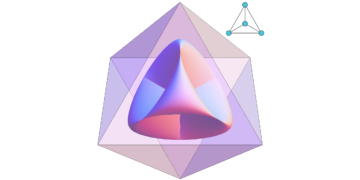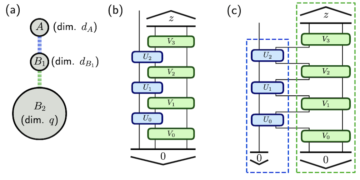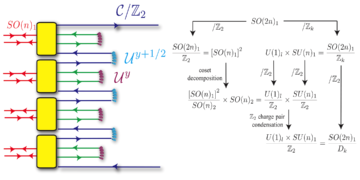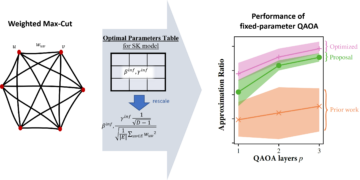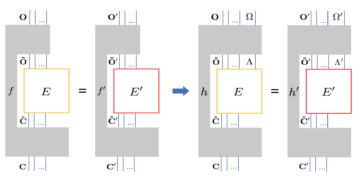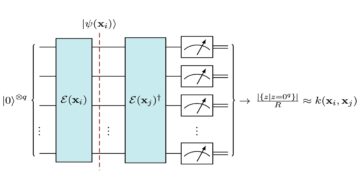
Department of Physics, Virginia Polytechnic Institute and State University, 24061 Blacksburg, VA, USA
Virginia Tech Center for Quantum Information Science and Engineering, Blacksburg, VA 24061, USA
Find this paper interesting or want to discuss? Scite or leave a comment on SciRate.
Abstract
Multipartite entangled states are an essential resource for sensing, quantum error correction, and cryptography. Color centers in solids are one of the leading platforms for quantum networking due to the availability of a nuclear spin memory that can be entangled with the optically active electronic spin through dynamical decoupling sequences. Creating electron-nuclear entangled states in these systems is a difficult task as the always-on hyperfine interactions prohibit complete isolation of the target dynamics from the unwanted spin bath. While this emergent cross-talk can be alleviated by prolonging the entanglement generation, the gate durations quickly exceed coherence times. Here we show how to prepare high-quality GHZ$_M$-like states with minimal cross-talk. We introduce the $M$-tangling power of an evolution operator, which allows us to verify genuine all-way correlations. Using experimentally measured hyperfine parameters of an NV center spin in diamond coupled to carbon-13 lattice spins, we show how to use sequential or single-shot entangling operations to prepare GHZ$_M$-like states of up to $M=10$ qubits within time constraints that saturate bounds on $M$-way correlations. We study the entanglement of mixed electron-nuclear states and develop a non-unitary $M$-tangling power which additionally captures correlations arising from all unwanted nuclear spins. We further derive a non-unitary $M$-tangling power which incorporates the impact of electronic dephasing errors on the $M$-way correlations. Finally, we inspect the performance of our protocols in the presence of experimentally reported pulse errors, finding that XY decoupling sequences can lead to high-fidelity GHZ state preparation.
Popular summary
Utilizing defect platforms for quantum technologies requires precise control over the electron-nuclear entanglement. Generating entanglement in these systems is challenging since the electron couples to multiple nuclei at once. One way to control these always-on interactions is by applying periodic pulses on the electron. This approach entangles the electron with a subset of spins from the nuclear register and “weakens” the remaining interactions. The isolation of the electron from some nuclei is often imperfect or demands extremely long pulses that lead to slow and faulty entanglement generation.
We provide a detailed analysis of the multipartite electron-nuclear entanglement structure in an arbitrarily large register and develop methods for its precise manipulation. This is done by designing entangling gates that maximize the so-called “all-way correlations” within a subsystem from the register and simultaneously suppress unintended interactions arising from the remaining spins. We inspect how residual correlations, control errors, or decoherence mechanisms modify the multipartite entanglement structure. Our analysis provides a complete understanding of the entanglement dynamics and paves the way for higher precision control techniques in nuclear-spin-based platforms.
► BibTeX data
► References
[1] Robert Raussendorf and Hans J. Briegel. “A one-way quantum computer”. Phys. Rev. Lett. 86, 5188–5191 (2001).
https://doi.org/10.1103/PhysRevLett.86.5188
[2] H. J. Briegel, D. E. Browne, W. Dur, R. Raussendorf, and M. Van den Nest. “Measurement-based quantum computation”. Nature 5, 19–26 (2009).
https://doi.org/10.1038/nphys1157
[3] Robert Raussendorf and Tzu-Chieh Wei. “Quantum computation by local measurement”. Annual Review of Condensed Matter Physics 3, 239–261 (2012).
https://doi.org/10.1146/annurev-conmatphys-020911-125041
[4] Sara Bartolucci, Patrick Birchall, Hector Bombin, Hugo Cable, Chris Dawson, Mercedes Gimeno-Segovia, Eric Johnston, Konrad Kieling, Naomi Nickerson, Mihir Pant, Fernando Pastawski, Terry Rudolph, and Chris Sparrow. “Fusion-based quantum computation”. Nat. Commun. 14, 912 (2023).
https://doi.org/10.1038/s41467-023-36493-1
[5] Mark Hillery, Vladimír Bužek, and André Berthiaume. “Quantum secret sharing”. Phys. Rev. A 59, 1829–1834 (1999).
https://doi.org/10.1103/PhysRevA.59.1829
[6] W. Tittel, H. Zbinden, and N. Gisin. “Experimental demonstration of quantum secret sharing”. Phys. Rev. A 63, 042301 (2001).
https://doi.org/10.1103/PhysRevA.63.042301
[7] K. Chen and H.-K. Lo. “Conference key agreement and quantum sharing of classical secrets with noisy ghz states”. In Proceedings. International Symposium on Information Theory, 2005. ISIT 2005. Pages 1607–1611. (2005).
https://doi.org/10.1109/ISIT.2005.1523616
[8] Y.-J. Chang, C.-W. Tsai, and T. Hwang. “Multi-user private comparison protocol using ghz class states”. Quantum Inf. Process. 12, 1077–1088 (2013).
https://doi.org/10.1007/s11128-012-0454-z
[9] B. A. Bell, D. Markham, D. A. Herrera-Martí, A. Marin, W. J. Wadsworth, J. G. Rarity, and M. S. Tame. “Experimental demonstration of graph-state quantum secret sharing”. Nat. Commun. 5, 5480 (2014).
https://doi.org/10.1038/ncomms6480
[10] M. Leifgen, T. Schröder, F. Gädeke, R. Riemann, V. Métillon, E. Neu, C. Hepp, C. Arend, C. Becher, K. Lauritsen, and O. Benson. “Evaluation of nitrogen- and silicon-vacancy defect centres as single photon sources in quantum key distribution”. New. J. Phys. 16, 023021 (2014).
https://doi.org/10.1088/1367-2630/16/2/023021
[11] Nicoló Lo Piparo, Mohsen Razavi, and William J. Munro. “Memory-assisted quantum key distribution with a single nitrogen-vacancy center”. Phys. Rev. A 96, 052313 (2017).
https://doi.org/10.1103/PhysRevA.96.052313
[12] Norbert M. Linke, Mauricio Gutierrez, Kevin A. Landsman, Caroline Figgatt, Shantanu Debnath, Kenneth R. Brown, and Christopher Monroe. “Fault-tolerant quantum error detection”. Sci. Adv. 3, e1701074 (2017).
https://doi.org/10.1126/sciadv.1701074
[13] M. G. M. Moreno, A. Fonseca, and M. M. Cunha. “Using three-partite ghz states for partial quantum error detection in entanglement-based protocols”. Quantum Inf. Process. 17, 191 (2018).
https://doi.org/10.1007/s11128-018-1960-4
[14] N. H. Nickerson, Y. Li, and S. C. Benjamin. “Topological quantum computing with a very noisy network and local error rates approaching one percent”. Nat. Commun. 4, 1756 (2013).
https://doi.org/10.1038/ncomms2773
[15] B. A. Bell, D. A. Herrera-Martí, M. S. Tame, D. Markham, W. J. Wadsworth, and J. G. Rarity. “Experimental demonstration of a graph state quantum error-correction code”. Nat. Commun. 5, 3658 (2014).
https://doi.org/10.1038/ncomms4658
[16] G. Waldherr, Y. Wang, S. Zaiser, M. Jamali, T. Schulte-Herbrüggen, H. Abe, T. Ohshima, J. Isoya, J. F. Du, P. Neumann, and J. Wrachtrup. “Quantum error correction in a solid-state hybrid spin register”. Nature 506, 204–207 (2014).
https://doi.org/10.1038/nature12919
[17] T. H. Taminiau, J. Cramer, T. van der Sar, V. V. Dobrovitski, and R. Hanson. “Universal control and error correction in multi-qubit spin registers in diamond”. Nat. Nanotechnol. 9, 171–176 (2014).
https://doi.org/10.1038/nnano.2014.2
[18] J. Cramer, N. Kalb, M. A. Rol, B. Hensen, M. S. Blok, M. Markham, D. J. Twitchen, R. Hanson, and T. H. Taminiau. “Repeated quantum error correction on a continuously encoded qubit by real-time feedback”. Nat. Commun. 7, 11526 (2016).
https://doi.org/10.1038/ncomms11526
[19] M. H. Abobeih, Y. Wang, J. Randall, S. J. H. Loenen, C. E. Bradley, M. Markham, D. J. Twitchen, B. M. Terhal, and T. H. Taminiau. “Fault-tolerant operation of a logical qubit in a diamond quantum processor”. Nature 606, 884–889 (2022).
https://doi.org/10.5281/zenodo.6461872
[20] Zachary Eldredge, Michael Foss-Feig, Jonathan A. Gross, S. L. Rolston, and Alexey V. Gorshkov. “Optimal and secure measurement protocols for quantum sensor networks”. Phys. Rev. A 97, 042337 (2018).
https://doi.org/10.1103/PhysRevA.97.042337
[21] B. Koczor, S. Endo, T. Jones, Y. Matsuzaki, and S. C. Benjamin. “Variational-state quantum metrology”. New J. Phys. 22, 083038 (2020).
https://doi.org/10.1088/1367-2630/ab965e
[22] H. Bernien, B. Hensen, W. Pfaff, G. Koolstra, M. S. Blok, L. Robledo, T. H. Taminiau, M. Markham, D. J. Twitchen, L. Childress, and R. Hanson. “Heralded entanglement between solid-state qubits separated by three metres”. Nature 497, 86–90 (2013).
https://doi.org/10.1038/nature12016
[23] P. C. Humphreys, N. Kalb, J. P. J. Morits, R. N. Schouten, R. F. L. Vermeulen, D. J. Twitchen, M. Markham, and R. Hanson. “Deterministic delivery of remote entanglement on a quantum network”. Nature 558, 268–273 (2018).
https://doi.org/10.1038/s41586-018-0200-5
[24] M. Pompili, S. L. N. Hermans, S. Baier, H. K. C. Beukers, P. C. Humphreys, R. N. Schouten, R. F. L. Vermeulen, M. J. Tiggelman, L. dos Santos Martins, B. Dirkse, S. Wehner, and R. Hanson. “Realization of a multinode quantum network of remote solid-state qubits”. Sci. 372, 259–264 (2021).
https://doi.org/10.1126/science.abg1919
[25] S. L. N. Hermans, M. Pompili, H. K. C. Beukers, S. Baier, J. Borregaard, and R. Hanson. “Qubit teleportation between non-neighbouring nodes in a quantum network”. Nature 605, 663–668 (2022).
https://doi.org/10.1038/s41586-022-04697-y
[26] S. Zaiser, T. Rendler, I. Jakobi, T. Wolf, S.-Y. Lee, S. Wagner, V. Bergholm, T. Schulte-Herbrüggen, P. Neumann, and J. Wrachtrup. “Enhancing quantum sensing sensitivity by a quantum memory”. Nat. Commun. 7, 12279 (2016).
https://doi.org/10.1038/ncomms12279
[27] Alexandre Cooper, Won Kyu Calvin Sun, Jean-Christophe Jaskula, and Paola Cappellaro. “Environment-assisted quantum-enhanced sensing with electronic spins in diamond”. Phys. Rev. Applied 12, 044047 (2019).
https://doi.org/10.1103/PhysRevApplied.12.044047
[28] V. Vorobyov, S. Zaiser, N. Abt, J. Meinel, D. Dasari, P. Neumann, and J. Wrachtrup. “Quantum fourier transform for nanoscale quantum sensing”. Npj Quantum Inf. 7, 124 (2021).
https://doi.org/10.1038/s41534-021-00463-6
[29] N. Kalb, A. A. Reiserer, P. C. Humphreys, J. J. W. Bakermans, S. J. Kamerling, N. H. Nickerson, S. C. Benjamin, D. J. Twitchen, M. Markham, and R. Hanson. “Entanglement distillation between solid-state quantum network nodes”. Sci. 356, 928–932 (2017).
https://doi.org/10.1126/science.aan0070
[30] T. H. Taminiau, J. J. T. Wagenaar, T. van der Sar, F. Jelezko, V. V. Dobrovitski, and R. Hanson. “Detection and control of individual nuclear spins using a weakly coupled electron spin”. Phys. Rev. Lett. 109, 137602 (2012).
https://doi.org/10.1103/PhysRevLett.109.137602
[31] S. F. Huelga, C. Macchiavello, T. Pellizzari, A. K. Ekert, M. B. Plenio, and J. I. Cirac. “Improvement of frequency standards with quantum entanglement”. Phys. Rev. Lett. 79, 3865–3868 (1997).
https://doi.org/10.1103/PhysRevLett.79.3865
[32] André R. R. Carvalho, Florian Mintert, and Andreas Buchleitner. “Decoherence and multipartite entanglement”. Phys. Rev. Lett. 93, 230501 (2004).
https://doi.org/10.1103/PhysRevLett.93.230501
[33] C. E. Bradley, J. Randall, M. H. Abobeih, R. C. Berrevoets, M. J. Degen, M. A. Bakker, M. Markham, D. J. Twitchen, and T. H. Taminiau. “A ten-qubit solid-state spin register with quantum memory up to one minute”. Phys. Rev. X 9, 031045 (2019).
https://doi.org/10.1103/PhysRevX.9.031045
[34] C. T. Nguyen, D. D. Sukachev, M. K. Bhaskar, B. Machielse, D. S. Levonian, E. N. Knall, P. Stroganov, R. Riedinger, H. Park, M. Lončar, and M. D. Lukin. “Quantum network nodes based on diamond qubits with an efficient nanophotonic interface”. Phys. Rev. Lett. 123, 183602 (2019).
https://doi.org/10.1103/PhysRevLett.123.183602
[35] C. T. Nguyen, D. D. Sukachev, M. K. Bhaskar, B. Machielse, D. S. Levonian, E. N. Knall, P. Stroganov, C. Chia, M. J. Burek, R. Riedinger, H. Park, M. Lončar, and M. D. Lukin. “An integrated nanophotonic quantum register based on silicon-vacancy spins in diamond”. Phys. Rev. B 100, 165428 (2019).
https://doi.org/10.1103/PhysRevB.100.165428
[36] A. Bourassa, C.r P. Anderson, K. C. Miao, M. Onizhuk, H. Ma, A. L. Crook, H. Abe, J. Ul-Hassan, T. Ohshima, N. T. Son, G. Galli, and D. D. Awschalom. “Entanglement and control of single nuclear spins in isotopically engineered silicon carbide”. Nat. Mater. 19, 1319–1325 (2020).
https://doi.org/10.1038/s41563-020-00802-6
[37] M. H. Abobeih, J. Randall, C. E. Bradley, H. P. Bartling, M. A. Bakker, M. J. Degen, M. Markham, D. J. Twitchen, and T. H. Taminiau. “Atomic-scale imaging of a 27-nuclear-spin cluster using a quantum sensor”. Nature 576, 411–415 (2019).
https://doi.org/10.1038/s41586-019-1834-7
[38] Evangelia Takou, Edwin Barnes, and Sophia E. Economou. “Precise control of entanglement in multinuclear spin registers coupled to defects”. Phys. Rev. X 13, 011004 (2023).
https://doi.org/10.1103/PhysRevX.13.011004
[39] H. Y. Carr and E. M. Purcell. “Effects of diffusion on free precession in nuclear magnetic resonance experiments”. Phys. Rev. 94, 630–638 (1954).
https://doi.org/10.1103/PhysRev.94.630
[40] S. Meiboom and D. Gill. “Modified spin‐echo method for measuring nuclear relaxation times”. Rev. Sci. Instrum. 29, 688–691 (1958).
https://doi.org/10.1063/1.1716296
[41] G. de Lange, Z. H. Wang, D. Ristè, V. V. Dobrovitski, and R. Hanson. “Universal dynamical decoupling of a single solid-state spin from a spin bath”. Sci. 330, 60–63 (2010).
https://doi.org/10.1126/science.1192739
[42] Terry Gullion, David B Baker, and Mark S Conradi. “New, compensated carr-purcell sequences”. Journal of Magnetic Resonance (1969) 89, 479–484 (1990).
https://doi.org/10.1016/0022-2364(90)90331-3
[43] G. S. Uhrig. “Exact results on dynamical decoupling by $pi$ pulses in quantum information processes”. New J. Phys. 10, 083024 (2008).
https://doi.org/10.1088/1367-2630/10/8/083024
[44] Götz S. Uhrig. “Keeping a quantum bit alive by optimized ${pi}$-pulse sequences”. Phys. Rev. Lett. 98, 100504 (2007).
https://doi.org/10.1103/PhysRevLett.98.100504
[45] N. Zhao, J.-L. Hu, S.-W. Ho, J. T. K. Wan, and R. B. Liu. “Atomic-scale magnetometry of distant nuclear spin clusters via nitrogen-vacancy spin in diamond”. Nat. Nanotechnol 6, 242–246 (2011).
https://doi.org/10.1038/nnano.2011.22
[46] Zhi-Hui Wang, G. de Lange, D. Ristè, R. Hanson, and V. V. Dobrovitski. “Comparison of dynamical decoupling protocols for a nitrogen-vacancy center in diamond”. Phys. Rev. B 85, 155204 (2012).
https://doi.org/10.1103/PhysRevB.85.155204
[47] W. Dong, F. A. Calderon-Vargas, and S. E Economou. “Precise high-fidelity electron–nuclear spin entangling gates in nv centers via hybrid dynamical decoupling sequences”. New J. Phys. 22, 073059 (2020).
https://doi.org/10.1088/1367-2630/ab9bc0
[48] W. Pfaff, T. H. Taminiau, L. Robledo, Bernien H, M. Markham, D. J. Twitchen, and R. Hanson. “Demonstration of entanglement-by-measurement of solid-state qubits”. Nat. Phys. 9, 29–33 (2013).
https://doi.org/10.1038/nphys2444
[49] M. Abobeih. “From atomic-scale imaging to quantum fault-tolerance with spins in diamond”. PhD thesis. Delft University of Technology. (2021).
https://doi.org/10.4233/uuid:cce8dbcb-cfc2-4fa2-b78b-99c803dee02d
[50] Evangelia Takou. ““Code to simulate the GHZ states generation””. https://github.com/eva-takou/GHZ_States_Public (2023).
https://github.com/eva-takou/GHZ_States_Public
[51] D. Chruscinski and G. Sarbicki. “Entanglement witnesses: construction, analysis and classification”. J. Phys. A: Math. Theor. 47, 483001 (2014).
https://doi.org/10.1088/1751-8113/47/48/483001
[52] G. Carvacho, F. Graffitti, V. D’Ambrosio, B. C. Hiesmayr, and F. Sciarrino. “Experimental investigation on the geometry of ghz states”. Sci Rep. 7, 13265 (2017).
https://doi.org/10.1038/s41598-017-13124-6
[53] Qi Zhao, Gerui Wang, Xiao Yuan, and Xiongfeng Ma. “Efficient and robust detection of multipartite greenberger-horne-zeilinger-like states”. Phys. Rev. A 99, 052349 (2019).
https://doi.org/10.1103/PhysRevA.99.052349
[54] Jacob L. Beckey, N. Gigena, Patrick J. Coles, and M. Cerezo. “Computable and operationally meaningful multipartite entanglement measures”. Phys. Rev. Lett. 127, 140501 (2021).
https://doi.org/10.1103/PhysRevLett.127.140501
[55] Valerie Coffman, Joydip Kundu, and William K. Wootters. “Distributed entanglement”. Phys. Rev. A 61, 052306 (2000).
https://doi.org/10.1103/PhysRevA.61.052306
[56] Alexander Wong and Nelson Christensen. “Potential multiparticle entanglement measure”. Phys. Rev. A 63, 044301 (2001).
https://doi.org/10.1103/PhysRevA.63.044301
[57] Dafa Li. “The n-tangle of odd n qubits”. Quantum Inf. Process. 11, 481–492 (2012).
https://doi.org/10.1007/s11128-011-0256-8
[58] Ryszard Horodecki, Paweł Horodecki, Michał Horodecki, and Karol Horodecki. “Quantum entanglement”. Rev. Mod. Phys. 81, 865–942 (2009).
https://doi.org/10.1103/RevModPhys.81.865
[59] Yuriy Makhlin. “Nonlocal properties of two-qubit gates and mixed states, and the optimization of quantum computations”. Quantum Inf. Process. 1, 243–252 (2002).
https://doi.org/10.1023/A:1022144002391
[60] X. Li and D. Li. “Relationship between the n-tangle and the residual entanglement of even n qubits”. Quantum Info. Comput. 10, 1018-1028 (2010).
https://dl.acm.org/doi/abs/10.5555/2011451.2011462
[61] C. E. Bradley. “Order from disorder: Control of multi-qubit spin registers in diamond”. PhD thesis. Delft University of Technology. (2021).
https://doi.org/10.4233/uuid:acafe18b-3345-4692-9c9b-05e970ffbe40
[62] Andreas Osterloh, Jens Siewert, and Armin Uhlmann. “Tangles of superpositions and the convex-roof extension”. Phys. Rev. A 77, 032310 (2008).
https://doi.org/10.1103/PhysRevA.77.032310
[63] Robert Lohmayer, Andreas Osterloh, Jens Siewert, and Armin Uhlmann. “Entangled three-qubit states without concurrence and three-tangle”. Phys. Rev. Lett. 97, 260502 (2006).
https://doi.org/10.1103/PhysRevLett.97.260502
[64] Michael A. Nielsen and Isaac L. Chuang. “Quantum computation and quantum information: 10th anniversary edition”. Cambridge University Press. (2010).
https://doi.org/10.1017/CBO9780511976667
[65] Fan-Zhen Kong, Jun-Long Zhao, Ming Yang, and Zhuo-Liang Cao. “Entangling power and operator entanglement of nonunitary quantum evolutions”. Phys. Rev. A 92, 012127 (2015).
https://doi.org/10.1103/PhysRevA.92.012127
[66] Anthony W. Schlimgen, Kade Head-Marsden, LeeAnn M. Sager-Smith, Prineha Narang, and David A. Mazziotti. “Quantum state preparation and nonunitary evolution with diagonal operators”. Phys. Rev. A 106, 022414 (2022).
https://doi.org/10.1103/PhysRevA.106.022414
[67] Zhi-Hui Wang, Wenxian Zhang, A. M. Tyryshkin, S. A. Lyon, J. W. Ager, E. E. Haller, and V. V. Dobrovitski. “Effect of pulse error accumulation on dynamical decoupling of the electron spins of phosphorus donors in silicon”. Phys. Rev. B 85, 085206 (2012).
https://doi.org/10.1103/PhysRevB.85.085206
[68] T. Van der Sar. “Quantum control of single spins and single photons in diamond”. PhD thesis. Delft University of Technology. (2012).
[69] G. De Lange. “Quantum control and coherence of interacting spins in diamond”. PhD thesis. Delft University of Technology. (2012).
https://doi.org/10.4233/uuid:7e730d04-c04c-404f-a2a8-4a8e62a99823
[70] “https://cyberinitiative.org/”.
https://cyberinitiative.org/
[71] Christopher Eltschka, Andreas Osterloh, and Jens Siewert. “Possibility of generalized monogamy relations for multipartite entanglement beyond three qubits”. Phys. Rev. A 80, 032313 (2009).
https://doi.org/10.1103/PhysRevA.80.032313
[72] Paolo Zanardi, Christof Zalka, and Lara Faoro. “Entangling power of quantum evolutions”. Phys. Rev. A 62, 030301 (2000).
https://doi.org/10.1103/PhysRevA.62.030301
Cited by
[1] Khoi-Nguyen Huynh-Vu, Lin Htoo Zaw, and Valerio Scarani, “Certification of genuine multipartite entanglement in spin ensembles with measurements of total angular momentum”, arXiv:2311.00806, (2023).
[2] Regina Finsterhoelzl, Wolf-Rüdiger Hannes, and Guido Burkard, “High-Fidelity Entangling Gates for Electron and Nuclear Spin Qubits in Diamond”, arXiv:2403.11553, (2024).
[3] Dominik Maile and Joachim Ankerhold, “Performance of quantum registers in diamond in the presence of spin impurities”, arXiv:2211.06234, (2022).
The above citations are from SAO/NASA ADS (last updated successfully 2024-03-29 04:01:33). The list may be incomplete as not all publishers provide suitable and complete citation data.
On Crossref’s cited-by service no data on citing works was found (last attempt 2024-03-29 04:01:32).
This Paper is published in Quantum under the Creative Commons Attribution 4.0 International (CC BY 4.0) license. Copyright remains with the original copyright holders such as the authors or their institutions.
- SEO Powered Content & PR Distribution. Get Amplified Today.
- PlatoData.Network Vertical Generative Ai. Empower Yourself. Access Here.
- PlatoAiStream. Web3 Intelligence. Knowledge Amplified. Access Here.
- PlatoESG. Carbon, CleanTech, Energy, Environment, Solar, Waste Management. Access Here.
- PlatoHealth. Biotech and Clinical Trials Intelligence. Access Here.
- Source: https://quantum-journal.org/papers/q-2024-03-28-1304/
- :is
- :not
- ][p
- $UP
- 01
- 1
- 10
- 100
- 10th
- 11
- 12
- 127
- 13
- 14
- 15%
- 16
- 17
- 19
- 1999
- 2%
- 20
- 2000
- 2001
- 2005
- 2006
- 2007
- 2008
- 2009
- 2010
- 2011
- 2012
- 2013
- 2014
- 2015
- 2016
- 2017
- 2018
- 2019
- 2020
- 2021
- 2022
- 2023
- 2024
- 21
- 22
- 23
- 24
- 25
- 26
- 27
- 28
- 29
- 30
- 31
- 32
- 33
- 34
- 35%
- 36
- 39
- 4
- 40
- 41
- 42
- 45
- 46
- 48
- 49
- 5
- 50
- 51
- 52
- 54
- 55
- 58
- 6
- 60
- 62
- 65
- 66
- 67
- 7
- 70
- 72
- 77
- 8
- 80
- 89
- 9
- 90
- 97
- 98
- a
- above
- ABSTRACT
- access
- accumulation
- ACM
- Act
- active
- Additionally
- affiliations
- against
- Agreement
- Alexander
- alive
- All
- allows
- an
- analysis
- and
- anderson
- Angular
- Anniversary
- annual
- Anthony
- appealing
- applied
- Applying
- approach
- approaching
- arbitrarily
- ARE
- arising
- AS
- At
- attempt
- author
- authors
- availability
- b
- baker
- based
- BE
- Bell
- Benjamin
- between
- Beyond
- Bit
- BLOK
- bounds
- Break
- brown
- by
- cable
- Calvin
- cambridge
- CAN
- candidates
- cao
- captures
- caroline
- Center
- Centers
- centres
- Certification
- challenging
- chang
- chen
- Chris
- Christensen
- Christopher
- citing
- class
- classification
- Cluster
- code
- color
- comment
- Commons
- Communication
- comparison
- compensated
- complete
- computation
- computational
- computations
- computer
- computing
- Condensed matter
- constraints
- construction
- continuously
- contribute
- control
- controlled
- cooper
- copyright
- correlations
- coupled
- Creating
- cryptography
- data
- David
- de
- defect
- degen
- delivery
- demands
- demonstration
- Den
- derive
- designing
- detailed
- Detection
- develop
- Diamond
- difficult
- Diffusion
- discuss
- disorder
- Distant
- distribution
- done
- dong
- donors
- DOS
- due
- durations
- dynamics
- e
- edition
- Edwin
- efficient
- Electronic
- enables
- encoding
- engineered
- Engineering
- enhanced
- entanglement
- eric
- error
- Errors
- essential
- Ether (ETH)
- Even
- evolution
- evolutions
- exceed
- experiments
- extension
- extremely
- FAST
- faulty
- feedback
- Finally
- finding
- For
- found
- fourier
- Free
- Frequency
- from
- further
- gate
- Gates
- generalized
- generating
- generation
- genuine
- geometry
- graph
- gross
- hans
- harvard
- here
- high-quality
- higher
- holders
- How
- How To
- HTTPS
- hugo
- Hybrid
- i
- Imaging
- Impact
- imperfect
- in
- incorporates
- indirectly
- individual
- info
- information
- Institute
- institutions
- integrated
- interacting
- interactions
- interesting
- Interface
- International
- introduce
- investigation
- isolation
- ITS
- jacob
- JavaScript
- jonathan
- jones
- journal
- kenneth
- Key
- Kong
- large
- Last
- lead
- leading
- Leave
- Lee
- li
- License
- lin
- List
- local
- logical
- Long
- Lyon
- Manipulation
- mar
- mark
- math
- Matter
- Maximize
- May..
- meaningful
- measure
- measured
- measurement
- measurements
- measures
- measuring
- mechanisms
- Memories
- Memory
- method
- methods
- Metrology
- Michael
- minimal
- minute
- mixed
- modify
- Momentum
- Month
- multiple
- Nature
- Nest
- network
- networking
- networks
- New
- Nguyen
- no
- nodes
- nuclear
- NV
- of
- often
- on
- once
- ONE
- open
- operation
- Operations
- operator
- operators
- optimization
- optimized
- or
- original
- Other
- our
- over
- pages
- Paolo
- Paper
- parameters
- Park
- partial
- patrick
- paves
- percent
- performance
- periodic
- phd
- Photons
- Physics
- Platforms
- plato
- Plato Data Intelligence
- PlatoData
- possess
- power
- precise
- Precision
- preparation
- Prepare
- presence
- press
- private
- Proceedings
- process
- processes
- processing
- Processor
- prohibit
- properties
- protects
- protocol
- protocols
- provide
- provides
- published
- publisher
- publishers
- pulse
- Qi
- Quantum
- Quantum Computer
- quantum computing
- quantum entanglement
- quantum error correction
- quantum information
- quantum networking
- quantum networks
- Qubit
- qubits
- quickly
- R
- rarity
- Rates
- real-time
- references
- register
- registers
- relations
- relaxation
- remaining
- remains
- remote
- Reported
- requires
- resonance
- resource
- Results
- review
- ROBERT
- robust
- s
- santos
- SCI
- Science
- Secret
- secrets
- secure
- Sensitivity
- several
- sharing
- show
- Silicon
- silicon carbide
- simulate
- simultaneously
- since
- single
- slow
- some
- son
- sophia
- Sources
- sparrow
- Spin
- spin qubits
- spins
- standards
- State
- States
- store
- structure
- Study
- Successfully
- such
- suitable
- Sun
- Symposium
- Systems
- T
- Target
- Task
- tech
- techniques
- Technologies
- Technology
- that
- The
- The Register
- their
- theory
- These
- thesis
- they
- this
- three
- Through
- time
- times
- Title
- to
- Total
- Transform
- tsai
- under
- understanding
- university
- unwanted
- updated
- URL
- us
- use
- using
- van
- verify
- very
- via
- virginia
- volume
- W
- wang
- want
- was
- Way..
- we
- WELL
- which
- while
- william
- with
- within
- without
- Wolf
- Won
- wong
- works
- X
- xiao
- year
- Yuan
- zephyrnet
- zhang
- Zhao



